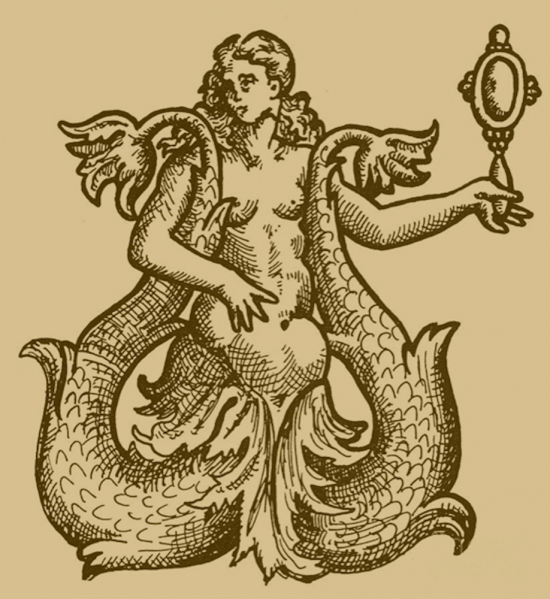A beautiful woman fixes her eyes on her beauty accessory, the mirror. She stares at herself again and again, and she does not even realise that the reflected image is not her pretty face but the buttocks of a devil that is making fun of her behind her back. Ancient engravings often show this paradoxical and satirical situation: the mirror is an instrument of vanitas, of that vacuousness which leads us to give weight to exterior appearances and importance to what fades away soon and disappears on the arrival of Death. The ancient warning is clear – to fall in love with one’s ephemeral appearances is only a way of clutching at illusions.
Conversely, the mirror has always been an object of wisdom: to look at oneself means to know oneself, and to become aware of one’s limits and transience. This is why the mirror is often represented in the hands of Providence, or of Philosophy. What does the mirror reflect in this particular case? Truth, honesty, what is inside the heart and its pureness.
In this ambivalence is rooted the mirror’s symbolic value: speculum is the etymological root of “speculation,” a highly intellectual activity that can prove to be elemental or deceitful. As any magical object, its power depends on who is using it. The same object in the hands of a wise or a stupid person produces totally opposite effects: you need to be aware of the mysteric relationship between one thing and its copy, its double. People formerly believed that mirrors could steal somebody’s soul, therefore children were usually not allowed to look at them, for fear that they could shorten their lives. Mirrors were covered when there was a dead person in the house, to prevent them from capturing the spirit of the deceased; and at the same time they could reveal the heart’s most intimate secrets, and even act as protection (as when you happen to meet the dreaded basilisks, or other demonic creatures that don’t cast any reflection or cast an hideous one that unmasks them).
As water bowls were formerly used as divination tools, the mirrors, that recall a mysterious and upturned world, can be used as charms against demons. The decorative etchings on Etrurian disc-shaped mirrors, made of polished bronze and silver, used to illustrate mythological themes, thus suggesting a much more complex usage than the mere cosmetic one.
Even in far-away countries, as Mexico, mirrors used to have an esoteric value. Made out of obsidian, a bright volcanic glass, they referred to the god Tezcatlipoca, that literally means “smoking mirror.” Siberian shamans could grasp the reverberation of the two big celestial mirrors that, according to their cosmology, reflected the whole universe. In the Shintoist tradition we find the well-known mirror of Amaterasu, the goddess of the Sun, and sacred mirrors are housed by several Japanese shrines too, away from ordinary mortals’ eyes. According to Siddhartha’s followers, the human soul should reflect “Buddha’s nature,” or, for the Taoists, “the Sky and the Earth” and so on. Even in the Western World, as God created man “in his own image,” man’s heart should become “a mirror that reflects God.” The soul has already been identified with the mirror, by Plato and by Plotino, and the whole world, in a sense, has always been its Creator’s reflection. Similarly, the mirror embodies the famous saying of Hermes’ Emerald Tablet, “that which is below is like that which is above.”
In Western iconography mirrors are ambivalent, they symbolize both the sun and the moon because a reflection is also an illusion: we can get lost or find ourselves inside it. The mirror is in the hands of the mermaids, as an emblem of luxury (lust and vanity), but it can also be found as an attribute of the virtues that preside over knowledge – and it even became, in the Christian era, one of the Virgin Mary’s accessories, because God wanted to see His own reflection in the Virgin, in order to create an image of Himself, his son, without infringing or altering the mirror itself.
The whole Creation, according to theologian Jacob Böhme (1575–1624), would be a sort of huge mirror, namely an enormous eye which is capable of admiring itself. This recalls the sublime moment, in Kurt Vonnegut’s Breakfast of Champions (1973) when, as he sees a graffito on a wall that asks “What is the purpose of life?”, the protagonist, answers, annoyed, “To be the eyes and ears and conscience of the Creator of the Universe, you fool!”.
Such is the mirror: it hands us our true face, the one that we could never see otherwise, just like a tooth can’t bite itself. “Something of us is external, because in the mirror we are actually out of ourselves. This calls forth the primeval sensation that the soul has been kidnapped. People that look at themselves in the mirror for a long time are fascinated by something that paralyzes them (...). Not everyone can stand looking at his/her own reflected image. Some people, like mythical Narcissus, get lost as they admire their own image reflected by the water. Other people come back to earth only after a complete transmigration, namely when, after having looked at themselves in the mirror, they have recovered their actual existence.” (E. Aeppli, Der Traum und seine Deutung, 1943)
At the beginning water was needed to reflect oneself, and this element is intimately linked with the true substance of things, with their continuous metamorphoses. For this reason the visions of Jean Cocteau – an artist that was fascinated by mirrors more than any other – are teeming of watery miroirs that can be crossed and give access to parallel worlds: on the other hand, he declares in Testament of Orpheus (1960) that mirrors show “Death at work”, namely our inexorable sliding down towards the abyss.






